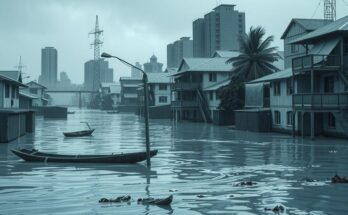Trinidad and Tobago will experience high temperatures reaching 34°C, with hazy conditions due to Saharan dust. Minimal showers may occur, and seas are moderate. Tidal and sunset information is provided for safe activities.
Residents of Trinidad and Tobago can expect a day characterized by high temperatures and hazy conditions due to Saharan dust lingering in the atmosphere. The Trinidad and Tobago Meteorological Service warns of potential highs reaching 34 degrees Celsius, particularly in Trinidad, coupled with isolated brief showers expected throughout the day and a fair and mostly clear night ahead. The air quality may pose challenges for individuals sensitive to dust, thus caution is advised.
For the remainder of the Lesser Antilles, fair weather is predicted, though clouds may intermittently obscure the sun with a few scattered showers anticipated at times. Minimum temperatures recorded last night were 24.3 degrees Celsius in Trinidad and 26.9 degrees Celsius in Tobago, with forecasted maximums of 34 degrees Celsius for Trinidad and 31 degrees Celsius for Tobago.
Sea conditions are described as moderate, with wave heights reaching up to two meters, potentially increasing to 2.5 meters in open waters around the Leewards, while sheltered areas should experience calmer waters of less than one meter. This information is essential for maritime activities in the region.
Furthermore, the day’s sunrise occurred at 6:10 AM while sunset is expected at 6:16 PM. Tidal information includes high tides at 7:06 AM and 8:12 PM for Trinidad, and 6:38 AM and 7:48 PM for Tobago, alongside low tides at 12:45 AM and 2:07 PM for Trinidad, and 12:20 PM and 1:39 PM for Tobago, providing vital information for those engaged in coastal activities.
In conclusion, Trinidad and Tobago’s weather is marked by elevated temperatures and hazy conditions due to Saharan dust. While the forecast indicates a possibility of isolated showers, nighttime conditions are expected to be mostly clear. Residents are encouraged to take precautions related to air quality, remain informed about sea conditions, and note the tides for safe coastal practices.
Original Source: tt.loopnews.com




